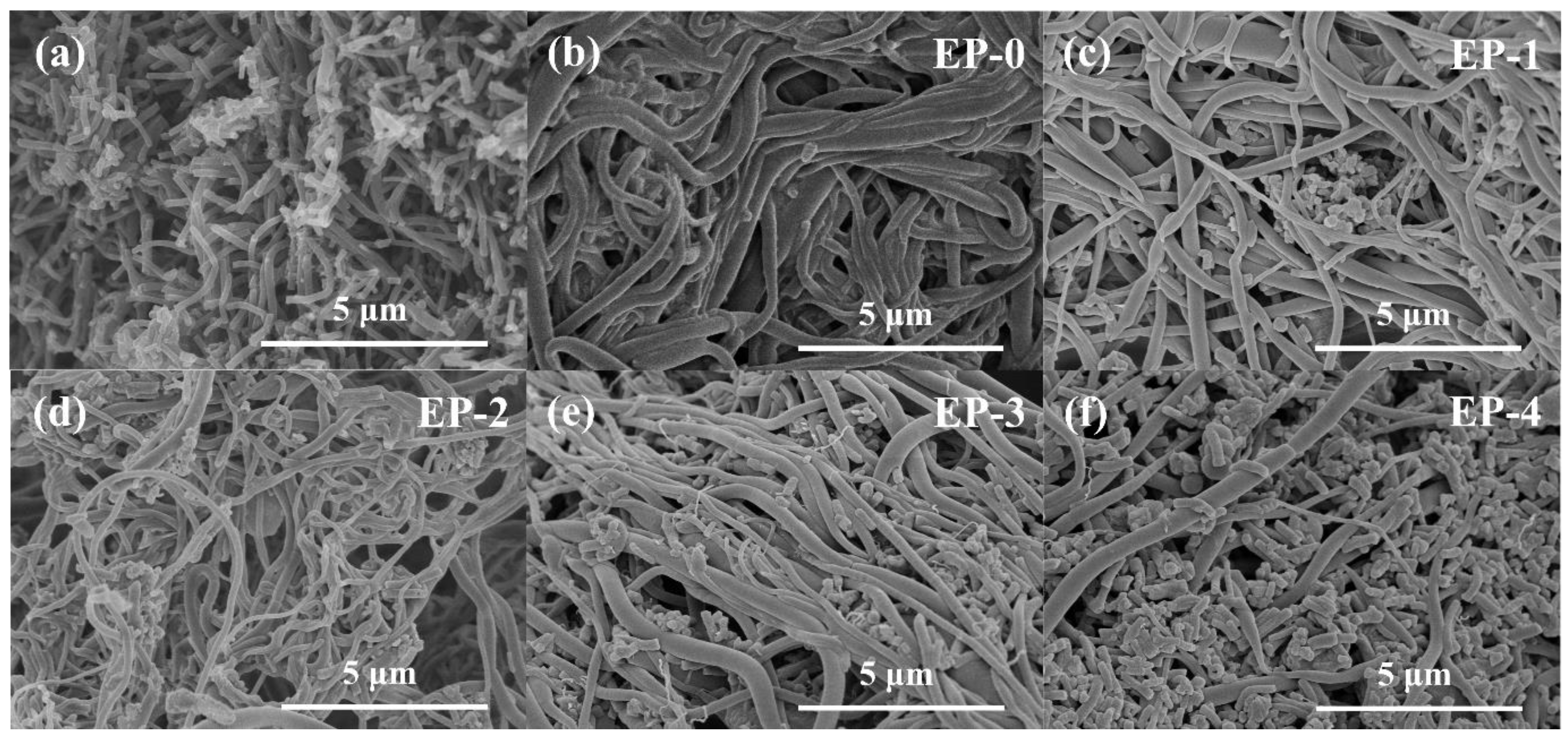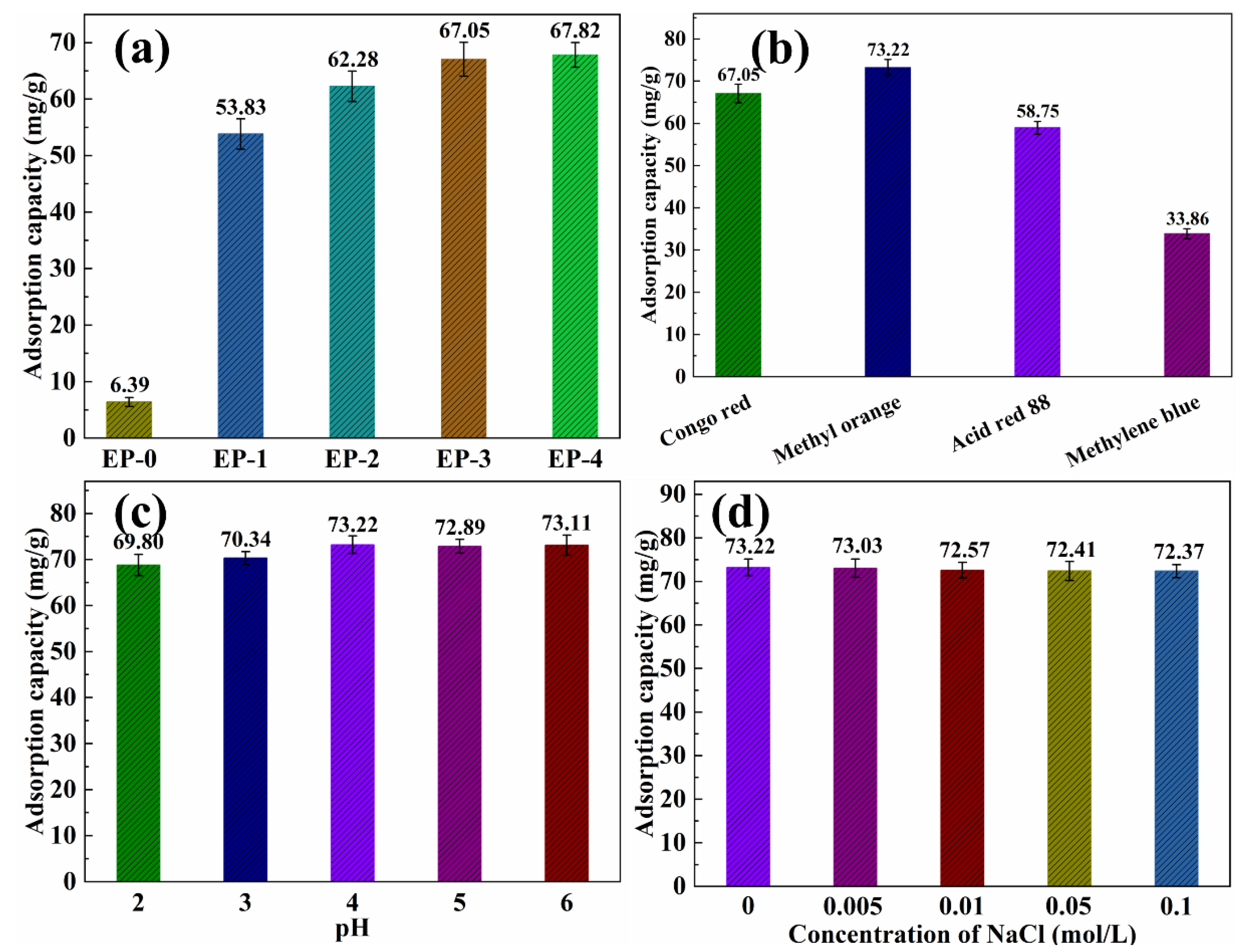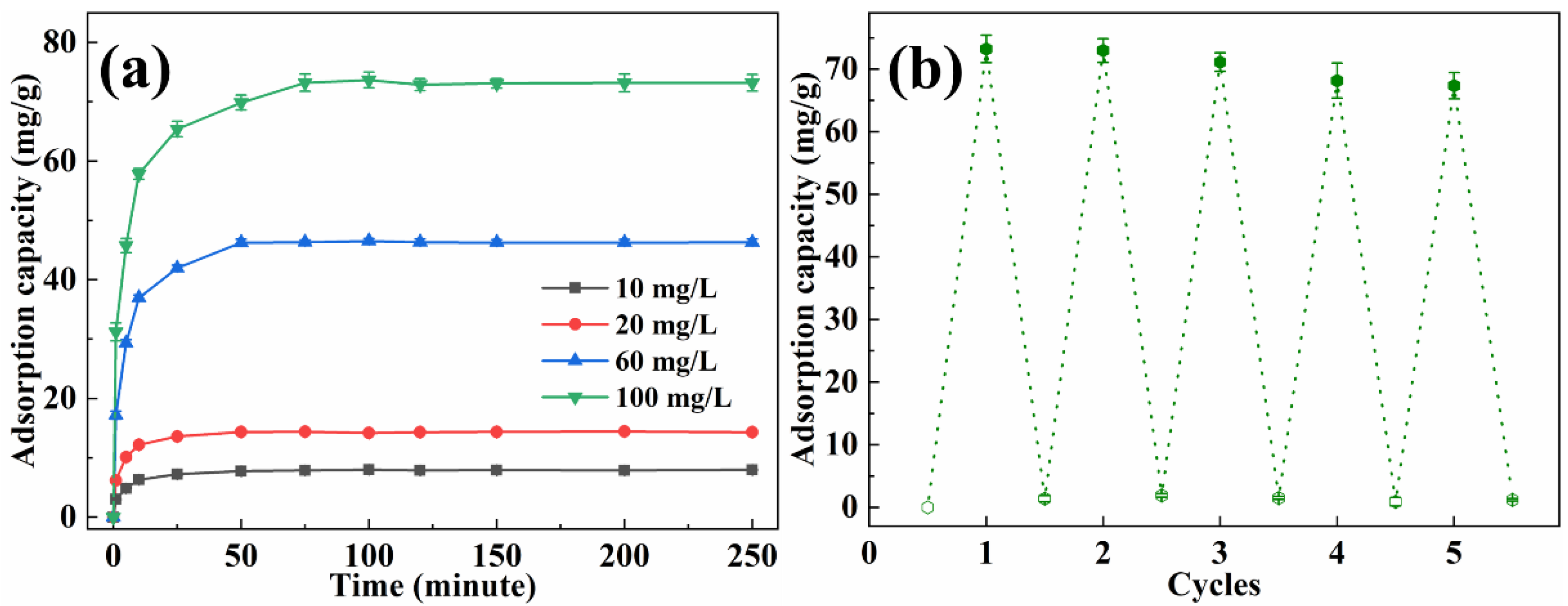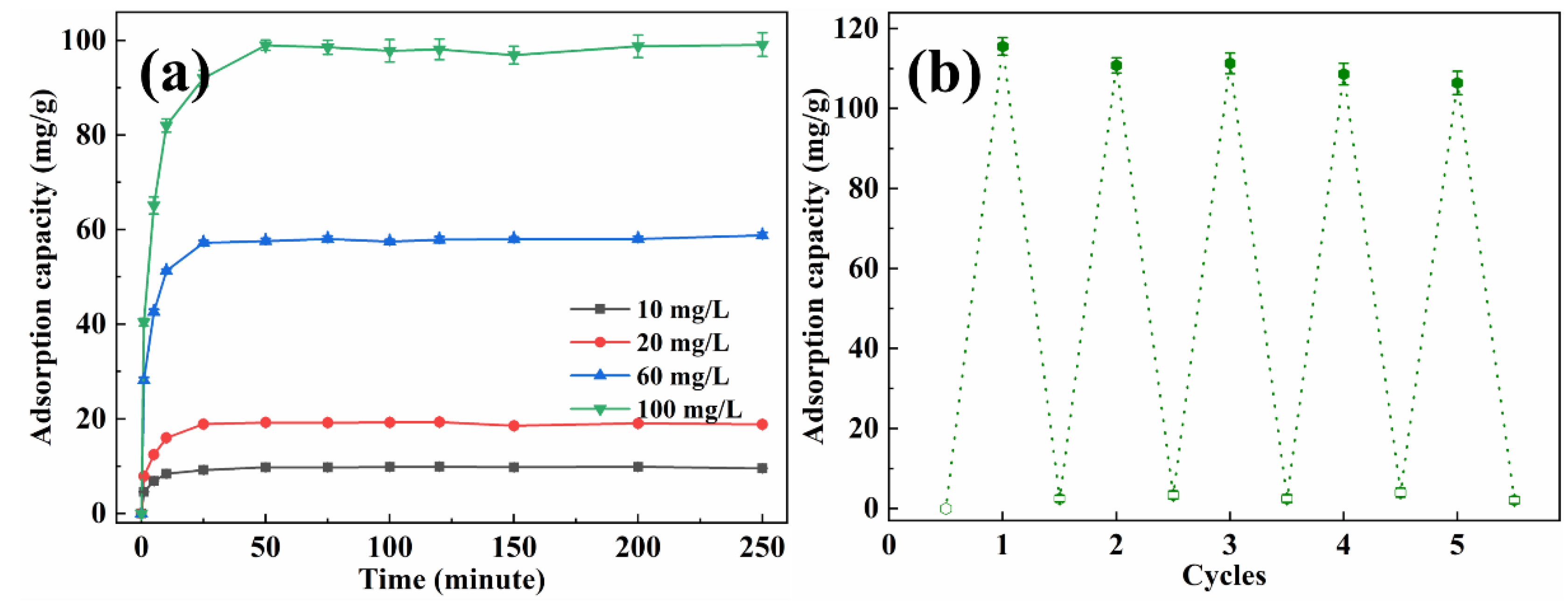Fabrication of EVOH/PANI Composite Nanofibrous Aerogels for the Removal of Dyes and Heavy Metal Ions
Abstract
:1. Introduction
2. Experimental Section
2.1. Materials
2.2. Preparation of PANI Nanorods
2.3. Fabrication of EVOH/PANI Composite NFAs
2.4. Characterization and Measurements
2.5. Adsorption Performance Measurements
2.5.1. Dyes Adsorption Performance Measurements
2.5.2. Heavy Metal Ion’s (Cr(VI)) Adsorption Performance Measurements
2.6. The Influence Factors on Adsorption Performance
2.7. Recyclable Adsorption Performance Measurements
3. Results and Discussion
3.1. Design and Construction of EVOH/PANI Composite NFAs
3.2. Morphologies and Structure
3.3. Mechanical Properties
3.4. Surface Wettability
3.5. Adsorption Performance
3.5.1. Dyes Adsorption
3.5.2. Heavy Metal Ions Adsorption
4. Conclusions
Supplementary Materials
Author Contributions
Funding
Institutional Review Board Statement
Informed Consent Statement
Data Availability Statement
Conflicts of Interest
References
- Wang, F.; Dai, J.W.; Huang, L.Q.; Si, Y.; Yu, J.Y.; Ding, B. Biomimetic and Superelastic Silica Nanofibrous Aerogels with Rechargeable Bactericidal Function for Antifouling Water Disinfection. ACS Nano 2020, 14, 8975–8984. [Google Scholar] [CrossRef] [PubMed]
- Lu, J.; Jiang, Y.; Xiao, R.; Jacob, K.I.; Tao, L.; Li, S.; Guo, L. Chemical Vapor Deposition Based Superelastic and Superhydrophoboic Thermoplastic Polymeric Nanofibrous Aerogels for Water Purification. J. Inorg. Organomet. Polym. Mater. 2022, 32, 2975–2985. [Google Scholar] [CrossRef]
- He, X.; Cheng, L.; Wang, Y.; Zhao, J.; Zhang, W.; Lu, C. Aerogels from Quaternary Ammonium-Functionalized Cellulose Nanofibers for Rapid Removal of Cr(VI) from Water. Carbohydr. Polym. 2014, 111, 683–687. [Google Scholar] [CrossRef] [PubMed]
- Patra, B.N.; Majhi, D. Removal of Anionic Dyes from Water by Potash Alum Doped Polyaniline: Investigation of Kinetics and Thermodynamic Parameters of Adsorption. J. Phys. Chem. B 2015, 119, 8154–8164. [Google Scholar] [CrossRef]
- Esrafili, A.; Bagheri, S.; Kermani, M.; Gholami, M.; Moslemzadeh, M. Simultaneous Adsorption of Heavy Metal Ions (Cu2+ and Cd2+) from Aqueous Solutions by Magnetic Silica Nanoparticles (Fe3O4@SiO2) Modified using EDTA. Desalin. Water Treat. 2019, 158, 207–215. [Google Scholar] [CrossRef] [Green Version]
- Zekavat, S.R.; Raouf, F.; Talesh, S. Simultaneous Adsorption of Cu2+ and Cr (VI) using HDTMA-Modified Zeolite: Isotherm, Kinetic, Mechanism, and Thermodynamic Studies. Water Sci. Technol. 2020, 82, 1808–1824. [Google Scholar] [CrossRef]
- Song, P.; Cui, J.W.; Di, J.; Liu, D.B.; Xu, M.Z.; Tang, B.J.; Zeng, Q.S.; Xiong, J.; Wang, C.D.; He, Q.; et al. Carbon Microtube Aerogel Derived from Kapok Fiber: An Efficient and Recyclable Sorbent for Oils and Organic Solvents. ACS Nano 2020, 14, 595–602. [Google Scholar] [CrossRef]
- Ma, Y.Y.; He, D.Y.; Liu, J.D.; Wang, Y.N.; Yang, M.; Wang, H.; Qiu, J.; Li, W.Y.; Li, Y.X.; Wang, C. Adsorption and Visible Light Photocatalytic Degradation of Electrospun PAN@W18O49 Nanofibers. Chem. Res. Chin. Univ. 2021, 37, 428–435. [Google Scholar] [CrossRef]
- Farooq, N.; Khan, M.I.; Shanableh, A.; Qureshi, A.M.; Jabeen, S.; Rehman, A.U. Synthesis and Characterization of Clay Graphene Oxide Iron Oxide (clay/GO/Fe2O3)-Nanocomposite for Adsorptive Removal of Methylene Blue Dye from Wastewater. Inorg. Chem. Commun. 2022, 145, 109956. [Google Scholar] [CrossRef]
- Tang, C.X.; Brodie, P.; Li, Y.Z.; Grishkewich, N.J.; Brunsting, M.; Tam, K.C. Shape Recoverable and Mechanically Robust Cellulose Aerogel Beads for Efficient Removal of Copper Ions. Chem. Eng. J. 2020, 392, 124821. [Google Scholar] [CrossRef]
- Nafi, A.W.; Taseidifar, M. Removal of Hazardous Ions from Aqueous Solutions: Current methods, with A Focus on Green Ion Flotation. J. Environ. Manage. 2022, 319, 115666. [Google Scholar] [CrossRef] [PubMed]
- Yu, X.Y.; Huang, M.Q.; Wang, X.Y.; Tang, G.; Du, M. Plasmon Silica Aerogel for Improving High-Temperature Solar Thermal Conversion. Appl. Therm. Eng. 2023, 219, 119419. [Google Scholar] [CrossRef]
- Wang, Y.Y.; Zhang, F.; Li, N.; Shi, J.F.; Jia, L.C.; Yan, D.X.; Li, Z.M. Carbon-Based Aerogels and Foams for Electromagnetic Interference Shielding: A Review. Carbon 2023, 205, 10–26. [Google Scholar] [CrossRef]
- Wu, H.; Chen, Y.; Chen, Q.; Ding, Y.; Gao, H. Synthesis of Flexible Aerogel Composites Reinforced with Electrospun Nanofibers and Microparticles for Thermal Insulation. J. Nanomater. 2013, 2013, 375093. [Google Scholar] [CrossRef]
- Si, Y.; Fu, Q.X.; Wang, X.Q.; Zhu, J.; Yu, J.Y.; Sun, G.; Ding, B. Superelastic and Superhydrophobic Nanofiber-Assembled Cellular Aerogels for Effective Separation of Oil/Water Emulsions. ACS Nano 2015, 9, 3791–3799. [Google Scholar] [CrossRef] [PubMed]
- Yan, Z.S.; Liu, X.Y.; Si, Y.; Dai, Z.J.; Yu, J.Y.; Ding, B. Ternary-Porous Conjugated N-Halamine Nanofibers/Graphene Aerogels for Rechargeable Degradation of Mustard Gas. Adv. Funct. Mater. 2022, 32, 202206018. [Google Scholar] [CrossRef]
- Zhang, R.A.; Wu, N.; Pan, F.; Yang, Y.F.; Li, B.; Wu, L.L.; Liu, W.; Liu, J.R.; Zeng, Z.H. Scalable Manufacturing of Light, Multifunctional Cellulose Nanofiber Aerogel Sphere with Tunable Microstructure for Microwave Absorption. Carbon 2023, 203, 181–190. [Google Scholar] [CrossRef]
- Lu, J.W.; Li, Y.; Song, W.; Losego, M.D.; Monikandan, R.; Jacob, K.I.; Xiao, R. Atomic Layer Deposition onto Thermoplastic Polymeric Nanofibrous Aerogel Templates for Tailored Surface Properties. ACS Nano 2020, 14, 7999–8011. [Google Scholar] [CrossRef]
- Fu, Q.X.; Liu, L.F.; Si, Y.; Yu, J.Y.; Ding, B. Shapeable, Underwater Superelastic, and Highly Phosphorylated Nanofibrous Aerogels for Large-Capacity and High-Throughput Protein Separation. ACS Appl. Mater. Interfaces 2019, 11, 44874–44885. [Google Scholar] [CrossRef]
- Cao, L.T.; Si, Y.; Wu, Y.Y.; Wang, X.Q.; Yu, J.Y.; Ding, B. Ultralight, Superelastic and Bendable Lashing-Structured Nanofibrous Aerogels for Effective Sound Absorption. Nanoscale 2019, 11, 2289–2298. [Google Scholar] [CrossRef]
- Ghosh, R. Protein Separation Using Membrane Chromatography: Opportunities and Challenges. J. Chromatogr. A 2002, 952, 13–27. [Google Scholar] [CrossRef]
- Li, J.W.; Zhou, Y.; Xu, J.; Gao, F.; Si, Q.K.; Wang, J.Y.; Zhang, F.; Wang, L.P. Water-Soluble and Degradable Gelatin/Polyaniline Assemblies with a High Photothermal Conversion Efficiency for pH-Switchable Precise Photothermal Therapy. ACS Appl. Mater. Interfaces 2022, 14, 52670–52683. [Google Scholar] [CrossRef] [PubMed]
- Wei, X.; Peng, Y.B.; Fang, W.X.; Hu, Z.Y.; Li, W.W.; Zhang, S.X.; Jin, J. A Polyaniline Nanofiber Array Supported Ultrathin Polyamide Membrane for Solar-Driven Volatile Organic Compound Removal. J. Mater. Chem. A 2022, 10, 20424–20430. [Google Scholar] [CrossRef]
- Xu, D.; Yan, S.; Weng, W.; Xiao, R. Cost Effective Nanofiber Composite Membranes for Cr(VI) Adsorption with High Durability. RSC Adv. 2016, 6, 44723–44731. [Google Scholar] [CrossRef]
- Mohammad, N.; Atassi, Y. Adsorption of Methylene Blue onto Electrospun Nanofibrous Membranes of Polylactic Acid and Polyacrylonitrile Coated with Chloride Doped Polyaniline. Sci. Rep. 2020, 10, 13412. [Google Scholar] [CrossRef]
- Mei, T.; Zhao, Q.H.; Chen, J.H.; You, H.N.; Chen, Z.; Xia, M.; Wang, D. Nanofiber-Based Aerogel Integrating Photothermal and Photocatalytic Properties for Efficient Wastewater Treatment. Compos. Commun. 2022, 35, 101348. [Google Scholar] [CrossRef]
- Xu, J.; Wang, J.; Wan, Y.C.; Cheng, P.; Geng, Y.; Xia, M.; Zheng, L.J.; Tan, Y.; Liu, K.; Wang, D. High-Yield of Nucleic Acid Adsorption via Poly(Vinyl Alcohol-co-Ethylene) Nanofiber-Based Anion-Exchange Chitosan Aerogel Membrane with Controllable Porosity. Adv. Mater. Interfaces 2022, 9, 202200613. [Google Scholar] [CrossRef]
- Zheng, Q.F.; Cai, Z.Y.; Gong, S.Q. Green Synthesis of Polyvinyl Alcohol (PVA)-Cellulose Nanofibril (CNF) Hybrid Aerogels and Their Use as Superabsorbents. J. Mater. Chem. A 2014, 2, 3110–3118. [Google Scholar] [CrossRef]
- Lu, J.W.; Xu, D.D.; Wei, J.K.; Yan, S.; Xiao, R. Superoleophilic and Flexible Thermoplastic Polymer Nanofiber Aerogels for Removal of Oils and Organic Solvents. ACS Appl. Mater. Interfaces 2017, 9, 25533–25541. [Google Scholar] [CrossRef]
- Yan, S.Y.; Lu, J.W.; Song, W.; Xiao, R. Flexible Triboelectric Nanogenerator Based on Cost-eEffective Thermoplastic Polymeric Nanofiber Membranes for Body-Motion Energy Harvesting with High Humidity-Resistance. Nano Energy 2018, 48, 248–255. [Google Scholar] [CrossRef]
- Liu, Q.Z.; Chen, J.H.; Mei, T.; He, X.W.; Zhong, W.B.; Liu, K.; Wang, W.W.; Wang, Y.D.; Li, M.F.; Wang, D. A Facile Route to the Production of Polymeric Nanofibrous Aerogels for Environmentally Sustainable Applications. J. Mater. Chem. A 2018, 6, 3692–3704. [Google Scholar] [CrossRef]
- Si, Y.; Yu, J.Y.; Tang, X.M.; Ge, J.L.; Ding, B. Ultralight Nanofibre-Assembled Cellular Aerogels with Superelasticity and Multifunctionality. Nat. Commun. 2014, 5, 5802. [Google Scholar] [CrossRef] [PubMed] [Green Version]
- Zhang, J.; Seeger, S. Polyester Materials with Superwetting Silicone Nanofilaments for Oil/Water Separation and Selective Oil Absorption. Adv. Funct. Mater. 2015, 21, 4699–4704. [Google Scholar] [CrossRef]
- Indira, P.; Ho, T.T.; Ahalya, N.; Sathish, T.; Saravanan, R.; Rajasimman, M.; Sudhakar, T. Magnetic Porous Ag2O/Chitin Nanostructure Adsorbent for Eco-Friendly Effective Disposing Azo Dyes. Environ. Res. 2023, 218, 114824. [Google Scholar] [CrossRef]
- Liu, H.F.; Wang, K.X.; Zhang, D.K.; Zhao, D.S.; Zhai, J.H.; Cui, W.G. Adsorption and Catalytic Removal of Methyl Orange from Water by PIL-GO/TiO2/Fe3O4 Composites. Mater. Sci. Semicond. Process. 2023, 154, 107215. [Google Scholar] [CrossRef]
- Stefa, S.; Griniezaki, M.; Dimitropoulos, M.; Paterakis, G.; Galiotis, C.; Kiriakidis, G.; Klontzas, E.; Konsolakis, M.; Binas, V. Highly Porous Thin-Layer g-C3N4 Nanosheets with Enhanced Adsorption Capacity. ACS Appl. Nano Mater. 2023, 6, 1732–1742. [Google Scholar] [CrossRef]
- Hu, Y.Q.; Hou, C.; An, J.; Fang, J.N.; Shi, Y.X.; Fan, Q.X.; Liu, G.Y.; Liu, Y.F. Fe3O4-Doped Silk Fibroin-Polyacrylamide Hydrogel for Selective and Highly Efficient Absorption of Cationic Dyes Pollution in Water. Nanotechnology 2022, 33, 265601. [Google Scholar] [CrossRef]
- Li, D.W.; Tao, Y.L.; Li, S.; Wu, Y.N.; Wang, C.R.; Lv, Y.R.; Zhu, G.S.; Qiu, H.F.; Liu, X.; Chen, C. Porous Cage-Like Microfiber of Fly Ash Magnetic Powder (CMS)/Polyaniline (PANI) Composites with Absorption Properties. Phys. Scr. 2022, 97, 085817. [Google Scholar] [CrossRef]
- Tai, S.Y.; Li, Y.; Yang, L.; Zhao, Y.; Wang, S.F.; Xia, J.X.; Li, H. Magnetic-Transition-Metal Oxides Modified Pollen-Derived Porous Carbon for Enhanced Absorption Performance. Int. J. Environ. Res. Public Health 2022, 19, 16740. [Google Scholar] [CrossRef]
- Turan, K.; Kalfa, O.M. Removal of Lead from Aqueous Solution Using Electrospun Nanofibers: Preparation, Characterization, Adsorption Isotherm, and Kinetic Study. Anal. Methods 2022, 14, 3382–3396. [Google Scholar] [CrossRef]
- Sanchez, J.; Dax, D.; Tapiero, Y.; Xu, C.L.; Willfor, S. Bio-Based Hydrogels With Ion Exchange Properties Applied to Remove Cu(II), Cr(VI), and As(V) Ions From Water. Front. Bioeng. Biotechnol. 2021, 9, 656472. [Google Scholar] [CrossRef]
- Jung, C.; Heo, J.; Han, J.; Her, N.; Lee, S.J.; Oh, J.; Ryu, J.; Yoon, Y. Hexavalent Chromium Removal by Various Adsorbents: Powdered Activated Carbon, Chitosan, and Single/Multi-Walled Carbon Nanotubes. Sep. Purif. Technol. 2013, 106, 63–71. [Google Scholar] [CrossRef]
- Karthik, R.; Meenakshi, S. Synthesis, Characterization and Cr(VI) Uptake Study of Polyaniline Coated Chitin. Int. J. Biol. Macromol. 2015, 72, 235–242. [Google Scholar] [CrossRef] [PubMed]
- Qusti, A.H. Removal of Chromium(VI) from Aqueous Solution using Manganese Oxide Nanofibers. J. Ind. Eng. Chem. 2014, 20, 3394–3399. [Google Scholar] [CrossRef]









| Sample Name | EVOH (g) | PANI (g) |
|---|---|---|
| EP-0 | 0.20 | 0.00 |
| EP-1 | 0.20 | 0.05 |
| EP-2 | 0.20 | 0.10 |
| EP-3 | 0.20 | 0.15 |
| EP-4 | 0.20 | 0.20 |
| Sample Name | Density (mg/cm3) | Porosity (%) |
|---|---|---|
| EP-0 | 12.12 | 98.86 |
| EP-1 | 14.77 | 98.78 |
| EP-2 | 19.42 | 98.42 |
| EP-3 | 24.03 | 98.08 |
| EP-4 | 30.29 | 97.61 |
Disclaimer/Publisher’s Note: The statements, opinions and data contained in all publications are solely those of the individual author(s) and contributor(s) and not of MDPI and/or the editor(s). MDPI and/or the editor(s) disclaim responsibility for any injury to people or property resulting from any ideas, methods, instructions or products referred to in the content. |
© 2023 by the authors. Licensee MDPI, Basel, Switzerland. This article is an open access article distributed under the terms and conditions of the Creative Commons Attribution (CC BY) license (https://creativecommons.org/licenses/by/4.0/).
Share and Cite
Zhu, J.; Lu, H.; Song, J. Fabrication of EVOH/PANI Composite Nanofibrous Aerogels for the Removal of Dyes and Heavy Metal Ions. Materials 2023, 16, 2393. https://doi.org/10.3390/ma16062393
Zhu J, Lu H, Song J. Fabrication of EVOH/PANI Composite Nanofibrous Aerogels for the Removal of Dyes and Heavy Metal Ions. Materials. 2023; 16(6):2393. https://doi.org/10.3390/ma16062393
Chicago/Turabian StyleZhu, Junshan, Hang Lu, and Jianan Song. 2023. "Fabrication of EVOH/PANI Composite Nanofibrous Aerogels for the Removal of Dyes and Heavy Metal Ions" Materials 16, no. 6: 2393. https://doi.org/10.3390/ma16062393







